Sergio Pascolo
Botticino (brescia)Municipal stadium - Botticino (BS)
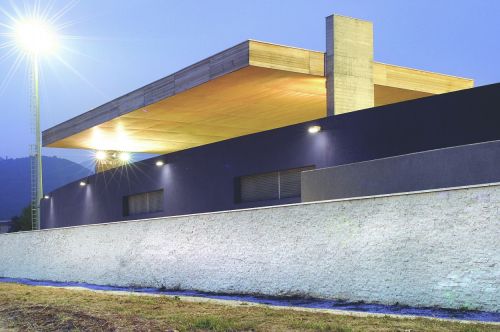
Cliente: comune di botticino
Progetto: 2000
Data di completamento: 2006
Area del sito: 88.000 mq
Superficie totale: 2.000 mq
Lo stadio comunale fa parte del centro sociale, sportivo e culturale di botticino. Come le altre strutture del centro, era situato lungo il bordo del nuovo parco cittadino. La sua integrazione con il contesto circostante è stata ottenuta attraverso l'uso di materiali, come quelli del teatro (pietra, gesso e legno), e attraverso elementi paesaggistici che riducono l'impatto della recinzione attorno al campo di gioco e creano una continuità visiva tra campo di gioco chiuso e aree verdi aperte al pubblico.
Le strutture dello stadio sono costituite da tre blocchi disposti linearmente lungo il lato ovest del campo di gioco, con cortili interni tra di loro. Gli alloggi per gli atleti si trovano all'estremità sud, gli stand di 70 metri sono al centro e gli impianti per gli spettatori sono a nord.
Gli stand sono caratterizzati da un arco nella parete posteriore che dà forma alle rampe di ingresso dello spettatore e definisce l'area d'ingresso per gli spettatori e gli atleti come uno spazio architettonico.
Client: comune di botticino
Project: 2000
Completion date: 2006
Site area: 88.000 mq
Total floor area: 2.000 mq
The municipal stadium is part of the botticino social, sports and cultural centre. Like the other structures of the centre, it was sited along the edge of the new city park. Its integration with the surrounding context was achieved through the use of materials, the same as those of the theatre (stone, plaster and wood), and through landscaping elements which reduce the impact of the fence around the playing field and create visual continuity between the enclosed playing field and the green areas open to the public.
The stadium structures consist of three blocks arranged linearly along the west side of the playing field, with interior courtyards between them. The athlete’s quarters are located on the south end, the 70 m long stands are at the centre, and the spectators’ facilities are to the north.
The stands are characterised by an arch at the rear wall which gives form to the spectator entry ramps and defines the entrance area for spectators and athletes as an architectural space.
GöttingenIntegrative housing, 98 units - Venezia (VE)
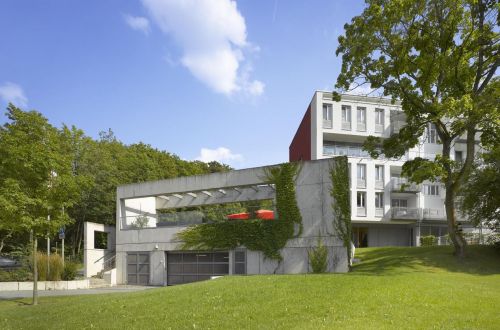
Cliente: städtische wohnungsbau gmbh
2003 (fase 1), 2007 (fase 2), 2011 (fase 3), 2015 (fase 4)
Area del sito: 13.500 mq
Superficie costruita: 10.600
"il progetto di alfred-delp-weg göttingen è considerato uno dei pochi esempi brillanti degli ultimi anni di un progetto di edilizia residenziale di alta qualità ea basso costo. Anche l'impegno positivo del cliente städtische wohnungsbau gmbh göttingen è considerato degno di nota. Il programma prevede la costruzione di 105 appartamenti e 400 metri quadrati per esigenze di lavoro e ristorazione. Il corpo dell'edificio, sviluppato su quattro piani, presenta una tipologia stabile e non innovativa in quanto gli appartamenti sono distribuiti a coppie da una scala, orientata tutto est-ovest. Sul lato del giardino, la facciata ha una griglia molto regolare, che ha balconi di diversa profondità a seconda degli usi previsti. In questo modo, ogni appartamento ha uno spazio aperto sufficiente ma unico. Il valore particolare del progetto sta nel suo carattere urbano. Raramente nelle costruzioni residenziali, c'è stata una configurazione così speciale; una leggera curva della strada crea il primo impatto nella percezione dello spazio, evocando immediatamente l'idea di un quartiere residenziale all'interno di una forte urbanità. Il piano terra dell'edificio consente la visualizzazione di singole unità abitative, rompendo il tipico effetto lineare della costruzione. L'unità dell'intero complesso scultoreo è rafforzata, creando un "luogo" o "quartiere". L'edificio risplende di vita urbana, non solo per la forma ma anche per il concetto di colori audaci. Questo aspetto, insieme alla sua estetica materiale, è considerato particolarmente encomiabile. Nel complesso, raggiunge un'atmosfera di alta intensità del "presente", senza essere vincolato alla moda del momento, creando un valore permanente per il futuro. "
Client: städtische wohnungsbau gmbh
2003 (phase 1), 2007 (phase 2), 2011 (phase 3), 2015 (phase 4)
Site area: 13.500 mq
Built area: 10.600
“the project on the alfred-delp-weg göttingen is considered one of the few shining examples in recent years of a high-quality, low-cost affordable housing project. The positive engagement of the client städtische wohnungsbau gmbh göttingen is also considered noteworthy. The program involves the construction of 105 apartments and 400 square meters for business and catering needs. The body of the building, developed over four floors, does presents a stable, not innovative typology in that the apartments are distributed in pairs by a staircase, all oriented east-west. On the garden side, the facade has a very regular grid, which has balconies of different depths depending on their intended uses. In this way, every apartment has a sufficient yet unique open space. The particular value of the project lies in its urban character. Rarely in residential construction, has there been such a special configuration; a slight bend of the road creates the first impact in the perception of space, immediately evoking the idea of a residential neighborhood within a strong urbanity. The building’s ground floor allows for the viewing of individual residential units, breaking the typical linear effect of construction. The unity of the entire sculptural complex is strengthened, creating a “place,” or “neighborhood.” the building glows with urban living, not only for the shape but also for the bold color concept. This aspect, together with its material aesthetics is considered particularly commendable. Overall, it reaches an atmosphere of high intensity of the “present,” without being bound to the fashion of the moment, creating a permanent value for the future.”
Shanghai30 townhouses on water - Venezia (VE)
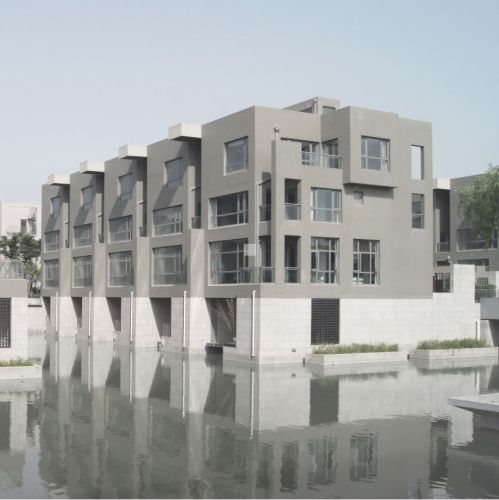
Cliente: shanghai highpower - oct ltd
Progetto: 2005
Data di completamento: 2011
Area del sito: 3.960 mq
Superficie totale: 7.740 mq
Il progetto consiste nella pianificazione di dieci case a schiera nella nuova città di pujiang, nel sobborgo di shanghai.
La situazione urbana e il programma funzionale suggeriscono di sviluppare queste case a schiera come una serie di volumi individuali, in cui ogni unità è sviluppata come una sorta di "villa verticale".
Partendo da un elemento monolitico, le cinque unità sono scolpite nel volume con un taglio profondo, modellando le unità che definiscono la trasparenza attraverso la profondità della casa dall'ingresso alle terrazze, modellando balconi e logge ai piani superiori. Il "taglio" nel volume oltre a definire l'individualità di ogni casa porta la luce al suo interno a diversi livelli.
I due edifici hanno allo stesso tempo un carattere compatto nel suo insieme, a causa dell'aspetto monolitico dei volumi, e un'immagine amichevole e confortevole delle singole case a causa della scala ridotta della singola unità.
Il canale tra gli edifici risulta come uno spazio centrale da cui le unità hanno accesso sul lato dell'acqua.
Client: shanghai highpower – oct ltd
Project: 2005
Completion date: 2011
Site area: 3.960 mq
Total floor area: 7.740 mq
The project consists in the planning of ten townhouses in pujiang new town, in the suburb of shanghai.
The urban situation and the functional program suggest to develop these townhouses as a series of individual volumes, in which each unit is developed as a sort of “vertical villa”.
Starting from a monolithic element, the five units are carved into the volume with a deep cut, modelling the units defining transparency through the depth of the house from the entrance to the terraces, shaping balconies and loggias on the upper floors. The “cut” in the volume other than defining the individuality of each house brings light to its interior on different levels.
The two buildings have at the same time a compact character as a whole, because of the monolithic aspect of the volumes, and a friendly and comfortable image of the individual houses due to the reduced scale of the single unit.
The channel in between the buildings results as a central space from which the units have access on the water side.
Göttingendwelling for 96 students - Venezia (VE)
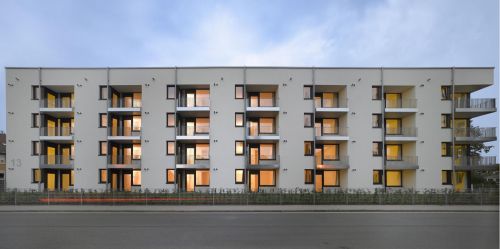
Cliente: städtidsche wohnungsbau gmbh
Progetto: 2011
Data di completamento: 2015
Area del sito: 3.000 mq
Superficie costruita: 4.000 mq
Sul sito di un edificio degli anni '60, che non è più utilizzabile, dovrebbe essere costruito un edificio di 4-5 piani. Per mezzo della sua struttura pianificata, lo spazio abitativo e il pavimento saranno raddoppiati. Questo edificio vede la sistemazione di 96 appartamenti per studenti, che sono progettati e ottimizzati in modo tale da essere poi usati come appartamenti per gli anziani nel 2025. Le camere e il design degli interni sono allestiti in modo che solo piccole modifiche debbano essere fatte per il previsto cambio di abitanti. Il potenziale di utilizzo del piano terra e dei livelli superiori per lo scambio sociale e le attività individuali o di gruppo conferisce all'edificio un vantaggio integrale come centro di scambio tra generazioni e come acceleratore per una migliore socialità per l'intera area.
Client: städtidsche wohnungsbau gmbh
Project: 2011
Completion date: 2015
Site area: 3.000 mq
Built area: 4.000 mq
On the site of a building from the 1960s, which is no longer usable, a 4-5 storey housing is supposed to be constructed. By means of its planned structure, the living and floor space will be doubled. This building sees the settling of 96 student appartments, which are planned and optimized in such a way that they will then be used as appartments for the elderly in 2025. The rooms and interior design are fitted so that only small changes will have to done for the planned change of inhabitants. The potential of using the ground floor as well as the upper levels for social exchange and individual or group activities, awards the building with an integral advantage as centre for exchange between
Generations and as accelerator for improved sociality for the entire area.
Göttingenmultigeneration living, 74 dwelling - Venezia (VE)
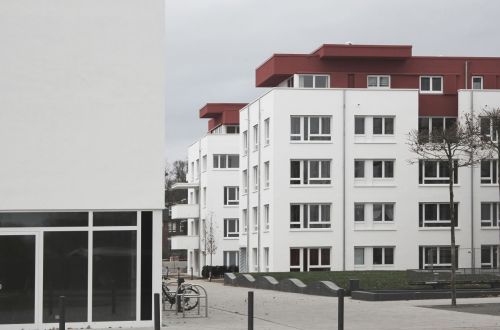
Cliente: städtische wohnungsbau gmbh
Competizione internazionale su invito, 2008
2 ° premio
Area del sito: 25.500 mq
Superficie costruita: 18.000 mq
L'area del progetto si trova in una posizione chiave tra l'area metropolitana della città e l'ambiente naturale a sud di gottinga: kiessee stadtpark, insieme all'ampia area del kleingärten (klein gardens), costituiscono le aree verdi più importanti del città.
Leinekanal, le ville urbane del xix secolo sul lato orientale, sono il collegamento tra il terreno e il centro medievale. La proposta di progetto evidenzia questa straordinaria condizione morfologica utilizzando la geometria per focalizzare i blocchi di lotzestraße in una forma a tre isole circondata da spazi verdi e raggruppati attorno a una piazza pedonale centrale. L'obiettivo è creare un ambiente urbano che sia ancora legato alla natura; multiuso in quanto esistono spazi per incontro, gioco, relax, urbanizzazione, natura; utilizzando obiettivi di socializzazione e tranquillità simultanee.
Esistono tre piani chiaramente definiti e indipendenti: tecnici, operativi e architettonici. Lavorano in armonia per offrire una combinazione flessibile di blocchi abitativi e spazi polifunzionali. Fuori dalle tre "isole" c'è un quarto elemento, "edificio" che crea una sorta di cerniera tra il nuovo quartiere e la città, dove l'edificio diventa un segnale (punto di riferimento) e un punto d'incontro con funzioni aziendali e sociali (bar, ristoranti, negozi, uffici, spazi per eventi, mostre, spettacoli) per aziende, residenti e dintorni.
Client: städtische wohnungsbau gmbh
International competition by invitation, 2008
2° award
Site area: 25.500 mq
Built area: 18.000 mq
The project area is located in a key position between the metropolitan area of the city and the natural environment in the south of göttingen: kiessee stadtpark, together with the extensive area of the kleingärten (klein gardens), constitute the most important green areas of the city.
Leinekanal, the nineteenth-century urban villas on the eastern side, are the link between the terrain and medieval centre. The project proposal highlights this extraordinary morphological condition by using geometry to focus the lotzestraße building blocks in a three-island form surrounded by green space and gathered around a central pedestrian plaza. The goal is to create an urban environment that is still tied to nature; multipurpose in that spaces exist for meeting, play, relaxation, urbanisation, nature; utilising goals of simultaneous socialisation and tranquillity.
Three clearly defined and independent plans exist: technical, operational, and architectural. They work in harmony to offers a flexible combination of housing blocks and multipurpose space. Outside the three “islands” there is a fourth element, “building” that creates a kind of hinge between the new district and the city, where the building becomes a signal (landmark) and a meeting place with business and social functions (bars, restaurants, shops, offices, event spaces, exhibitions, performances) for companies, residents and the surrounding neighbourhood.
Botticino (brescia)Multipurpose theatre - Botticino (BS)
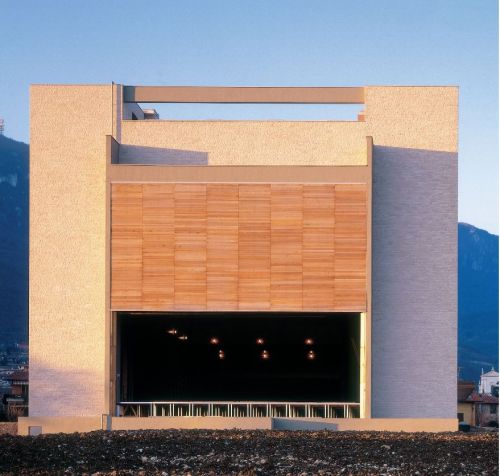
Cliente: comune di botticino
Progetto: 1998
Data di completamento: 2004
Area del sito: 88.000 mq
Superficie totale: 2.200 mq
Questo teatro polivalente è stato progettato per offrire alla comunità uno spazio per ospitare molti tipi diversi di spettacoli ed eventi. Quadrato in pianta e con un volume esterno prismatico compatto, l'edificio è simile per tipologia alla torre della città, simbolo della comunità e riferimento alla vita pubblica dei suoi cittadini.
All'interno, un volume cavernoso a tutta altezza comprende lo spazio centrale. è circondato da gallerie su tre lati e su tre livelli, e dal palco sul quarto lato. Le funzioni dell'edificio sono disposte su tre piani. Il principale auditorium da 300 posti ha un pavimento piano ed è dotato di montante retrattile per formare le bancarelle per le performance che richiedono questo tipo di posti a sedere. Con le alzate riposte, lo spazio del pavimento dell'auditorium può essere utilizzato anche per altri tipi di eventi e mostre, con i posti a sedere riposti. Ci sono anche piccole aree di spettacoli al piano interrato e sul tetto. Il carattere polifunzionale dell'edificio si basa sulla gamma di spazi disponibili e sulla flessibilità dell'auditorium principale, facilmente adattabile e facilmente trasformabile grazie alla seduta retrattile che consente una varietà di configurazioni. Dalla parte verso il parco, è possibile aprire il muro dietro il palco, trasformando l'auditorium in un palcoscenico per spettacoli all'aperto. I materiali esterni sono in marmo botticino, legno e vetro. All'interno, le superfici in cemento, mattoni e muratura sono dipinte di grigio in corrispondenza degli spazi di circolazione. L'auditorium principale è finito interamente in legno. Le strisce e le doghe sono disposte e scolpite in un design verticale e orizzontale, dando luogo a una "configurazione" acustica, definendo allo stesso tempo l'aspetto e il carattere architettonico dello spazio.
Client: comune di botticino
Project: 1998
Completion date: 2004
Site area: 88.000 mq
Total floor area: 2.200 mq
This multi-purpose theatre was designed to offer the community a space for hosting many different types of performances and events. Square in plan and with a compact prismatic exterior volume, the building is similar in typology to the city tower, a symbol of the community and a reference to the public life of its citizens.
Within, a cavernous full-height volume comprises the central space. It is surrounded by galleries on three sides and on three levels, and by the stage on the fourth side. The building’s functions are arranged on three floors. The main 300-seat auditorium has a level floor and is equipped with retractable riser to form the stalls for the performances which require this type of seating. With the risers stored away, the floor space of the auditorium space can also be used for various other types of events and exhibitions, with the seating stored away. There are also a small performances areas at the basement level and on the roof. The multi-purpose character of the building is based on the range of available performances spaces and on the flexibility of the main auditorium, easily adaptable and readily transformed by means of the retractable seating thus allowing a variety of configurations. On the side towards the park, the wall behind the stage can be opened, transforming the auditorium into a stage for outdoor performances. The exterior materials are botticino marble, wood and glass. Inside, concrete, brick-masonry and plastered surfaces are painted grey in correspondence to the circulation spaces. The main auditorium is finished entirely in wood. The strips and slats are arranged and carved in a vertical and horizontal design, resulting in an acoustic „configuration“, while at the same time defining the appearance and the architectural character of the space.
Göttingen24 social housing units - Venezia (VE)
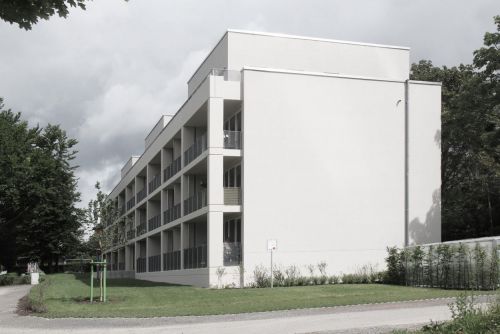
Göttingen
24 social housing units
Milanpenthouse with roof terrace - Milano (MI)
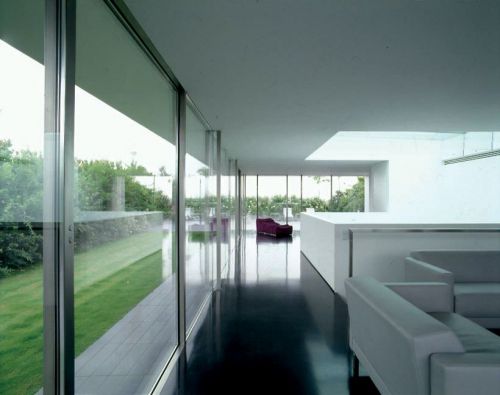
Cliente: privato
Progetto: 1999
Data di completamento: 2000
Area del sito: 700 mq
Superficie totale: 170 mq
Questo progetto riguarda la costruzione di un attico al livello del giardino sul tetto di un edificio residenziale di otto piani nel centro della città di milano.
La struttura dell'attico è composta da due elementi costruttivi: un tetto piano la cui struttura snella assume la forma di una superficie bianca orizzontale e un perimetro verticale completamente trasparente, in vetro dal pavimento al soffitto. Punteggiato solo da sottili supporti in acciaio satinato, le pareti vetrate estendono l'interno verso la terrazza del giardino sul tetto e oltre, attraverso il paesaggio urbano di milano.
Il punto focale del progetto è il lucernario centrale in vetro che copre lo spazio a doppia altezza che collega l'attico all'appartamento sottostante.
Sia le pareti portanti che il tetto sono stati costruiti utilizzando pannelli prefabbricati in legno, mentre le colonne 6 × 6 cm sono in acciaio satinato. Per la costruzione della struttura della facciata in vetro sono stati utilizzati profili in acciaio spazzolato 6 × 4 cm. Supportano pannelli in vetro da 190 × 235 cm in entrambi i telai fissi e operativi. Le finestre operative sono motorizzate e controllate elettronicamente. In tutta la casa abbiamo applicato un pavimento "terrazzo" resinoso, fluido e applicato con il marmo nero del passo.
Client: private
Project: 1999
Completion date: 2000
Site area: 700 mq
Total floor area: 170 mq
This project concerns the construction of a penthouse at the rooftop garden level of an eight floors residential building in the city centre of milan.
The penthouse structure consists of two building elements: a flat roof whose slender structure takes on the form of a horizontal white surface, and a completely transparent vertical perimeter, in glass from floor to ceiling. Punctuated only by slender supports in brushed steel, the glass walls extend the interior out to the rooftop garden terrace and beyond, across the cityscape of milan.
The focal point of the project is the full glass central skylight covering the double-height space which connect the penthouse to the apartment below.
Both bearing walls and roof were built using prefabricated wood panels, while the 6×6 cm columns are in brushed steel. 6×4 cm brushed steel sections were used to construct the framework of the glass facade. They support 190×235cm glass panels in both fixed and operable frames. The operable windows are motorized and controlled electronically. Throughout the home we apllied a seamless fluid-applied resinous „terrazzo“ flooring with pitch black belgian marble.
San dona’ di piave (venice)flexible green parking - San Donà di Piave (VE)
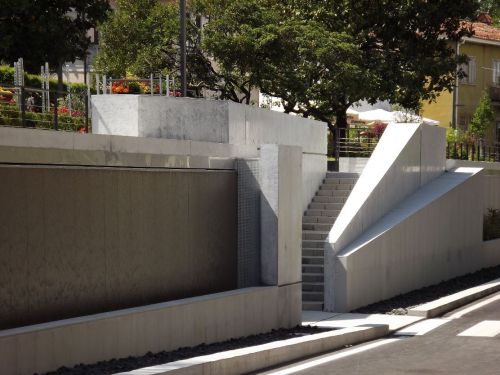
Cliente: comune di san donà di piave (ve)
Ristrutturazione di piazza donatori di sangue
Progetto: 2010
Data di completamento: 2012
Area del sito: 2.000 mq
La commissione per la costruzione di un parcheggio ha offerto l'opportunità di ripensare lo spazio urbano in modo flessibile: partendo dall'idea di preservare i preziosi alberi esistenti, la geometria dello spazio è stata ridefinita "attorno" alla natura. La geometria irregolare risultante da tale approccio trasforma lo spazio in una piazza-giardino dove le macchine coesistono con altri elementi. L'idea di un orto urbano è stata integrata con la presenza dell'acqua: il passaggio di livello da piazza a via diventa un terrapieno che ricollega alla presenza del fiume piave e riporta in città la percezione delle risorse vitali dell'uomo; l'attuale livello di spostamento è modellato da una superficie verticale sulla quale l'acqua scorre continuamente e da un canale orizzontale che evoca le abili opere di bonifica e canalizzazione tipiche del veneto. Automobili e pedoni si muovono su pavimenti in pietra, le piattaforme alla base degli alberi formano un sistema di zolle artificiali che articolano lo spazio come affioramenti e incorniciano la vegetazione.
Client: comune di san donà di piave (ve)
Refurbishment of piazza donatori di sangue
Project: 2010
Completion date: 2012
Site area: 2.000 mq
The commission to build a car park has provided an opportunity to rethink urban space in a flexible way: starting from the idea of preserving the valuable existing trees, the geometry of space has been redefined “around” nature. The irregular geometry resulting from such approach transforms the space in a garden-square where cars coexist with other elements. The idea of an urban garden has been integrated with the presence of water: the level shift from square to street becomes a water embankment reconnecting to the presence of the piave river and bringing the perception of man’s vital resources back in the city; the current level shift is shaped by a vertical surface over which water flows continuously and by a horizontal channel that evokes the skilful reclamation and canalization works typical of in the veneto region. Cars and pedestrians move on stone floorings, the platforms at the trees’ base form a system of man-made clods that articulate space like outcrops and frame the vegetation.
Venice3 stories privat house - Venezia (VE)
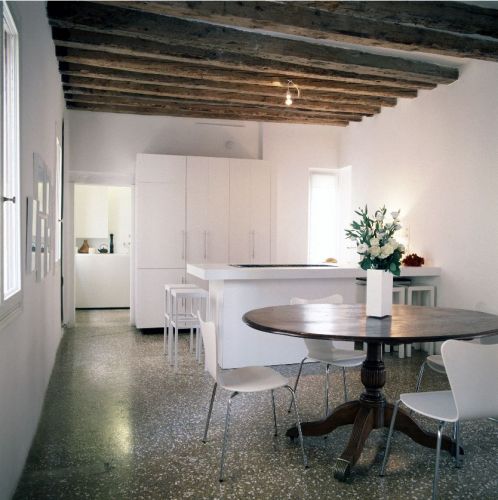
Client: private
Project: 2006
Completion date: 2006
Site area: 400 mq
Hamburgrefurbishment an ancient farmhouse - Venezia (VE)
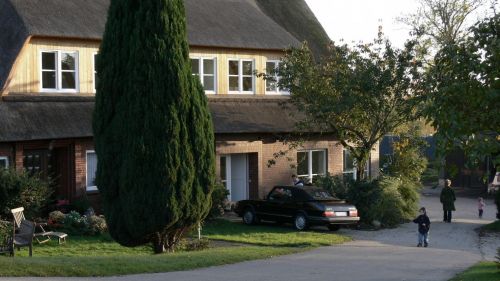
Cliente: privato
Progetto: 2006
Data di completamento: 2006
Area del sito: 400 mq
La fattoria è situata lungo le rive del fiume elba ai margini della città di amburgo. All'interno del complesso agricolo, l'unica costruzione abitabile immersa nel paesaggio della prateria settentrionale era l'antica casa colonica con il tipico tetto di paglia. I proprietari vivevano in una piccola parte dell'edificio, mentre la maggior parte veniva utilizzata come stalla per le mucche, con un fienile sopra. L'intero edificio è stato trasformato in una casa su tre piani senza modificare il volume esistente o le caratteristiche dell'esterno. Questa condizione da parte del cliente ci impone di lavorare all'interno della dicotomia tra la tradizionale busta tradizionale e la nuova spazialità interna. La zona giorno, al piano terra, occupa quello che una volta era la stalla. La tripartizione dello spazio è stata mantenuta, con una "navata centrale" come definita dalla struttura portante in legno, risultante in un ampio salone centrale, una zona studio ad ovest, e la cucina e la zona pranzo ad est. Le partizioni a altezza parziale nel blocco in muratura definiscono visivamente gli spazi senza chiuderli. A partire da un'altezza di due metri, la struttura in legno viene lasciata esposta e l'intera area abitativa viene percepita come un unico grande spazio, consentendo il passaggio della luce diffusa per tutto il giorno dalle finestre su tutti e tre i lati. Il piano superiore è stato ricostruito con una nuova struttura portante in legno. Sfruttando la conformazione verticale dell'edificio, è stata creata una grande galleria a doppia altezza che è diventata la sede centrale della vita privata della famiglia: un luogo dove giocare, conversare e studiare. Un balcone al piano superiore è l'area più riservata, utilizzata per leggere e rilassarsi, con una grande finestra che offre una vista in lontananza attraverso la prateria.
Client: private
Project: 2006
Completion date: 2006
Site area: 400 mq
The farm is situated along the banks of the elbe river at the edge of the city of hamburg. Within the agricultural complex, the only inhabitable building immersed in the northern prairie landscape was the ancient farmhouse with its typical thatched roof. The owners were living in a small part of the building, while most of it was used a stable for cows, with a hayloft above. The entire building was transformed into a home on three floors without modifying the existing volume or the characteristics of the exterior. This condition on the part of the client required us to work within the dichotomy between the historic traditional envelope and the new interior spatiality. The living area, at the ground floor, occupies what was once the stable. The tripartition of the space was maintained, with a “central nave” as defined by the bearing structure in wood, resulting in a large central living room, a study area to the west, and the kitchen and dining area to the east. Partial-height partitions in masonry block define the spaces visually without closing them off. From a height of two metres, the wood structure is left exposed and the entire living area is perceived as a single large space, permitting the passage of diffused light throughout the day from windows on all three sides. The upper floor was rebuilt with a new bearing structure in wood. Taking advantage of the vertical conformation of the building, a large double height gallery was created which became the central location for the family’s private life: a place to play, converse and study. A balcony at the upper floor is the most reserved area, used for reading and relaxing, with a large window providing a view far across the prairie.
Bressanone brixenrefurbishment and extension two ancient buildings - Venezia (VE)
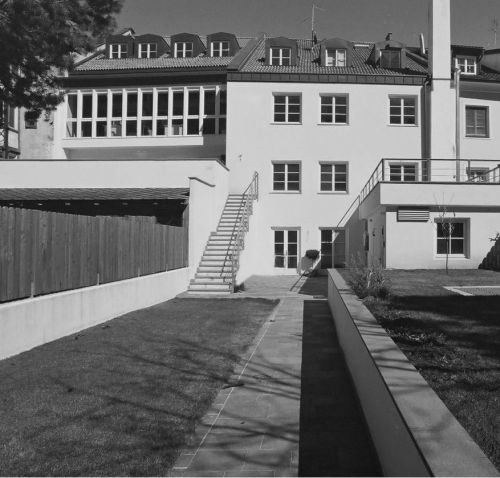
Bressanone brixen
Refurbishment and extension two ancient buildings
HelsinkyGuggenheim design competition - Venezia (VE)
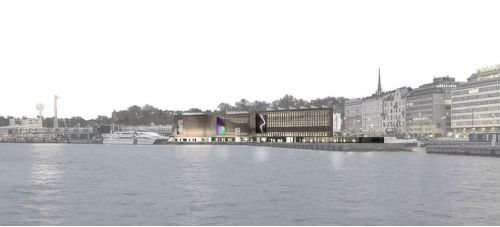
Il nuovo guggenheim helsinki ripristinerà la natura nella baia di helsinki: insegnerà al mondo un nuovo approccio all'habitat umano e all'urbanità, stimolando i cittadini e i visitatori allo stesso modo in un dialogo continuo sull'anima e l'essenza dell'umanità in relazione al suo habitat fisico. L'edificio è metaforicamente appoggiato su rocce che delimitano i moli portuali - dal grigio al verde! Gli elementi solidi e discontinui (rocce, pietre, muri curvi) creano uno spazio scorrevole composto da aree aperte e chiuse, diverse piattaforme e banchine. Sopra di esso, sorgono tre grandi elementi in legno che rappresentano la foresta, simbolo della forza e dell'intensità della natura. Quelle strutture in legno definiscono lo spazio espositivo interno dove la percezione dell'arte assumerà molteplici forme attraverso le variazioni di luce e una molteplicità di contenuti, raggiunte attraverso le tecnologie digitali. L'ambiente naturale reintegrato crea un nuovo spazio - adattabile, incrociabile e mobile - che rappresenta il nuovo stato di connettività che l'umanità cerca con il suo habitat: vivere nella natura attraverso forme, elementi e materiali naturali mentre percepisce e gode delle tecnologie digitali e delle esperienze multimediali.
The new guggenheim helsinki will restore nature in the helsinki bay: it will teach the world about a new approach to human habitat and urbanity, stimulating citizens and visitors alike to a continuous dialogue about the soul and essence of humanity in relation to its physical habitat.the building is metaphorically resting on rocks that border the harbour piers – from grey to green!the solid and discontinuous elements (rocks, stones, curved walls) create a flowing space composed of open and closed areas, different platforms and water tables. Above it, rise three large wooden elements that represent the forest, symbol for the everlasting strength and intensity of nature. Those wooden structures define the internal exhibition space where the perception of art will take on multiple forms through the variations of light and a multiplicity of content, achieved through digital technologies. The reinstated natural environment creates a new space – adaptable, crossable, and movable – which represents the new state of connectivity that humanity seeks with its habitat: living within nature through forms, elements and natural materials while perceiving and enjoying digital technologies and multimedia experiences.
GöttingenKunsthaus - Venezia (VE)
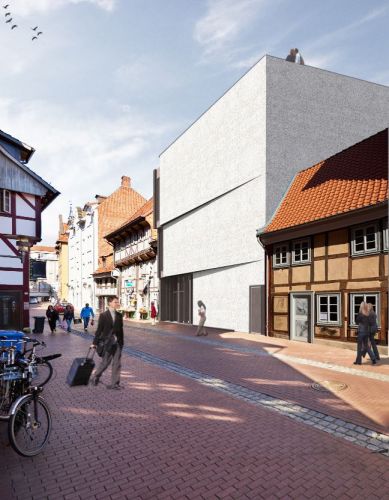
Göttingen
Kunsthaus
Linea sodesign objects - Venezia (VE)
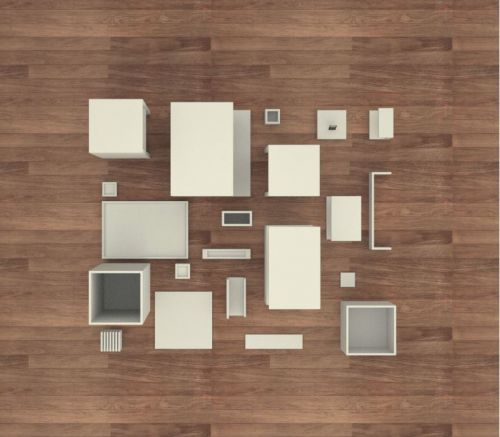
Linea so è una collezione di accessori e complementi d'arredo che riutilizza gli scarti della produzione di articoli di grandi dimensioni e dall'edilizia. Il materiale scartato e le talee vengono riassemblati in piccoli e preziosi prodotti artigianali e rispettosi dell'ambiente per la casa del futuro. L'intero processo, dalla produzione fino all'organizzazione di vendita e al confezionamento, viene effettuato in nome del riciclaggio e dello spreco zero. Al centro della collezione si trovano i materiali essenziali utilizzati, la loro geometria semplice e l'assenza di elementi superflui.
Linea so is a collection of home accessories and furnishings which re-uses scraps from the manufacture of large items and from the building industry. Discarded material and cuttings are reassembled into small precious handcrafted and environmentally sound products for the home of the future. The entire process, from the production through to the sales organisation and packaging is carried out in the name of recycling and zero waste. At the heart of the collection lie the essential materials used , their simple geometry and the absence of superfluous elements.
Romprimary school - Roma (RM)
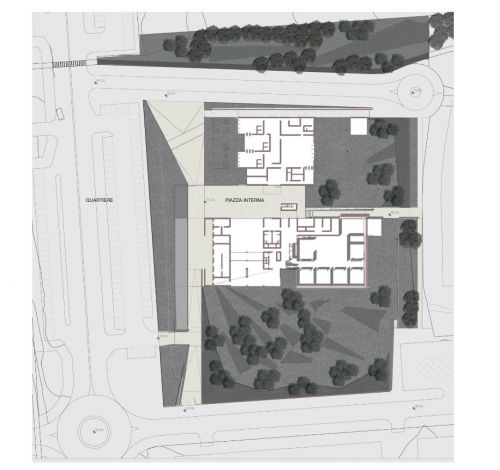
Cliente: comune di roma
Competizione internazionale in due fasi "meno è più 1", 2006
Progetto vincente - 1 ° premio
Area del sito: 9.000 mq
Superficie costruita: 3.740 mq
Il nuovo complesso scolastico sorge come un villaggio da un parco alberato con ulivi e circondato da mura che seguono la naturale pendenza del terreno. Quest'ultimo è stato mantenuto come una macchia di paesaggio naturale su cui riposano i tre edifici, a diversi livelli. Tre blocchi compatti con una configurazione metrica stereo sono disposti attorno a un quadrato interno, comune a entrambe le scuole. è un parco giochi per bambini, un luogo di incontro e di attesa per i genitori e diventa un'area urbana durante le vacanze scolastiche. Oltre alla piazza e ai giardini, anche l'auditorium, la mensa, la palestra e la biblioteca sono trasformati in aree comuni. I volumi compatti, le torri di illuminazione e ventilazione, i tetti piatti, perforati da feritoie per consentire alla luce naturale controllata di filtrare nelle aree comuni, le partizioni trasparenti, che sembrano estendere le aule al giardino, e ulteriori scelte tecnologiche fatte, come l'uso di apparecchiature solari e tecnologie a basso consumo energetico, hanno contribuito a realizzare un esemplare edificio sostenibile dal punto di vista ambientale. La geometria e la disposizione modulare dello spazio consentono di allestire aule e laboratori in base alle diverse esigenze educative attuali e future.
Client: comune di roma
International competition in two steps “meno è più 1”, 2006
Winning project – 1° premio
Site area: 9.000 mq
Built area: 3.740 mq
The new school complex rises like hamlet from parkland planted with olive trees and surrounded by walls which follow the natural incline of the land. The latter has been kept like a patch of natural landscape on which the three buildings rest, at different levels.
three compact blocks with a stereo metric configuration are set around an internal square, common to both schools. It is a playground for children, a meeting and waiting area for parents and becomes an urban area during school holidays. Besides the square and gardens, the auditorium, canteen, gym and library are also transformed into community areas.
the compact volumes, the light and ventilation towers, the flat roofs, which are perforated by slits so as to allow for controlled natural light to filter through into the common areas, the transparent partitions, which seem to extend the classrooms into the garden, and additional technological choices made such as the use of solar equipment and low energy technologies have contributed to an exemplary environmentally sustainable building.
the geometry and modular layout of the space allows the classrooms and laboratories to be set up according to various current and future educational needs.
Luganouniversity campus uni-supsi - Venezia (VE)

Prima fase
Area di progettazione: circa 22.200 m2
Superficie utile lorda: 37.000 m2
Il design trasforma l'area in un punto di riferimento per tutti i quartieri circostanti, fornendo un elemento di forte carattere urbano che completa l'area centrale della città a nord. Il nuovo "luogo" urbano sarà caratterizzato da una piazza verde delimitata dagli edifici universitari che incorniciano lo spazio centrale e pedonale come un palcoscenico. L'edificio per le strutture comuni sviluppate lungo il fiume emerge come la punta di un iceberg da un ambiente come un nuovo punto di riferimento urbano, nonché il simbolo riconoscibile del campus stesso. Lo spazio centrale è un luogo di incontro. I suoi ampi portici garantiscono l'accesso all'università e agli edifici delle strutture comuni. è anche concepito come luogo di riposo o al riparo dal sole, e come punto ricreativo con le sue mense o come luogo di riposo e relax lungo il fiume. Un ampio podio sopraelevato consente una migliore visione del fiume. A causa della pendenza del giardino centrale, crea una duna verde che confina con la piazza a sud e la protegge dalla vista e dal rumore del traffico lungo via la santa. Le superfici dietro gli edifici a ovest verso il confine dell'area sono anche trattate come argini verdi che completano l'area del campus. Quattro grandi tetti coprono i blocchi principali degli edifici e sono collegati in un sistema continuo di passaggi coperti. Sembrano enormi "foglie", diventano anche punti di riferimento urbani che forniscono al campus una caratteristica forte e unificante. Allo stesso tempo, ospitano gli estesi sistemi fotovoltaici e termici che forniscono energia rinnovabile a una parte significativa del campus. Competizione lanciata dalla scuola professionale universitaria della regione italiana della svizzera e dalla fondazione per i dipartimenti di lugano per conto dell'università della svizzera regione italianadesign in due fasi, 2011
First phase
Design area: about 22,200 m2
Gross usable surface: 37,000 m2
The design transforms the area into a landmark for all the surrounding districts by providing an element of strong urban character that completes the central area of the city at the north. The new urban “place” will feature a green square bordered by the university buildings that frame the central landscaped and pedestrian space like a backstage. The building for common facilities developed along the river emerges like the tip of an iceberg from such setting as a new urban landmark as well as the recognizable symbol of the campus itself. The central space is a meeting place. Its wide porches grant access to the university and the common facilities buildings. It is also conceived as a place for rest either in or sheltered from the sun, and as a recreational point with its cafeterias or as a place for rest and relax along the river.a large elevated podium allows for a better view of the river. Due to the slope of the central garden, it creates a green dune that borders the square to the south and protects it from view and from the noise of traffic along via la santa. The surfaces behind the buildings to the west towards the area’s border are also treated as green embankments that complete the campus area.four large roofs cover the buildings’ main blocks and are connected into a continuous system of covered passages. Looking like huge “leaves”, they also become urban landmarks that provide the campus with a strong and unifying feature. At the same time, they accommodate the expansive photovoltaic and thermal systems that provide renewable energy to a significant portion of the campus.competition launched by the university professional school of switzerland’s italian region and the foundation for the lugano departments on behalf of the university of switzerland’s italian regiondesign competition in two phases, 2011
Milan500 dwelling in a park - Milano (MI)
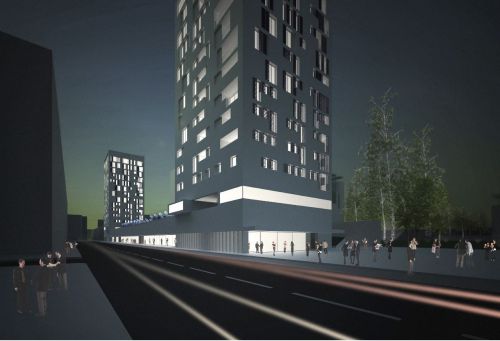
Cliente: pirelli re concorso "il centro di bicocca"
Concorrenza ristretta: 2008
Progetto vincente - 1 ° premio
Area del sito: 48.000 mq
Superficie totale: 49.500
Mqteam: masterplan e architettura: sergio pascolo architects, venezialandscape
Design: studio proap lisboa
Concetto di energia: transsolar gmbh, stuttgart strutturale
Ingegneria: studio sajni e zambetti, milano
Il progetto vede l'area della competizione come una possibilità di creare un grande polmone verde che completerebbe il distretto bicocca. Il suo slogan "alberri di bicocca" si riferisce a un sistema di edifici ispirati alla natura che fa spazio alla natura in città. Il progetto presenta un nuovo sistema abitativo che consente alle persone di vivere in un centro urbano vivace e dinamico e in un ambiente verde. Gli "alberi bicocca" sono dieci torri in pietra chiara che emergono da una grande piattaforma verde che costituisce il nuovo "parco centrale" "del distretto. è un punto di riferimento, un luogo per il relax e la ricreazione che offre un fresco rifugio in estate per i nuovi residenti e quelli nelle aree circostanti. La superficie costruita, composta da abitazioni e negozi, è montata su tre lati del terreno, in modo da liberare un'area di 30.000 metri quadrati che sarà designata come parco e ridisegnata con una nuova configurazione. Cinquecento alberi saranno piantati sul sito e le coperture delle aree commerciali saranno trasformate in terrazze con vista sul parco, giardini privati rialzati e aree sicure per giocare, leggere e rilassarsi. Una rete di portici crea una serie di coperture continue passerelle che si estendono su tutta la trama. Lungo questi ci saranno caffè, ristoranti e punti di incontro, lontani dal traffico e dalle strade rumorose. Ogni torre conterrà 11 tipi di appartamenti che vanno dai 42 ai 300 metri quadrati. La struttura, l'impiantistica e il sistema di facciata sono stati progettati per consentire la combinazione più flessibile dei diversi tipi di alloggio in ogni torre. Gli edifici in pietra bianca sono prismi semplici e regolari. Sono stati resi più leggeri da una serie di aperture che catturano le caratteristiche irregolari della vegetazione, e sono contrassegnate dalla superficie in pietra testurizzata e dal brise-soleil scorrevole in legno.
Client: pirelli re concorso “il centro di bicocca”
Restricted competition: 2008
Winning project – 1° premio
Site area: 48.000 mq
Total floor area: 49.500
Mqteam:masterplan and architecture: sergio pascolo architects, venezialandscape
Design: studio proap lisboa
Energy concept: transsolar gmbh, stuttgartstructural
Engineering: studio sajni e zambetti, milano
The project sees the competition area as a chance of creating a large green lung which would complete the bicocca district. Its slogan “alberi di bicocca” (bicocca trees) refers to a system of buildings inspired by nature which makes room for nature in the city. The project presents a new housing system enabling people to live both in a lively and dynamic city centre and in a green environment.the “bicocca trees” are ten light-coloured stone towers emerging from a large green platform which constitutes the new “central park” of the district. It is a reference point, a place for relaxation and recreation that provides a cool shelter in summer for the new residents and those in the surrounding areas. The built-up surface, consisting of housing and shops, is assembled along three sides of the plot, so as to clear an area of 30,000 sq. Metres which will be designated as parkland and redesigned with a new configuration. Five-hundred forest trees will be planted on the site and the roofing of the commercial areas will be turned into terraces overlooking the park, private raised gardens and safe areas for playing, reading and relaxing.a network of porticos creates a series of continuous covered walkways that spread out over the entire plot. Along these there will be cafés, restaurants and meeting points, placed away from the traffic and the noisy roads.each tower will contain 11 types of apartments ranging from 42 to 300 sq. Metres. The structure, the plant engineering and the façade system have been designed to allow the most flexible combination of the different types of accommodation in each tower.the white stone buildings are simple, regular prisms. They have been made lighter by a series of openings which capture the irregular characteristics of vegetation, and are marked by the textured stone surface and the wooden sliding brise-soleil.
Avellinochurch and parisch of s. Maria del carmine - Avellino (AV)
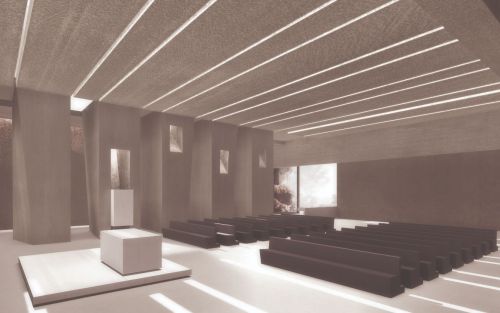
Cliente: cei
Concorrenza ristretta, 2007
Superficie costruita: 1.560 mq
Due semplici volumi rettangolari stereometrici costituiscono la forma del chiostro dell'edificio ecclesiastico e del complesso parrocchiale. Sono disposte intorno a un portico in legno a forma di croce, che consente l'accesso alla canonica, alle sale e agli uffici, collegandoli alla chiesa e alla sagrestia. La necessità di posizionare l'ingresso sullo stesso lato dell'altare è stato il pretesto per infondere costruire con la stessa forza fisica, simbolica e il significato del percorso sacramentale. Una profonda cavità segnala l'ingresso al volume monolitico della chiesa. è contrassegnato da un portone in legno a tutta altezza che segnala l'inizio di un percorso e ci persuade ad entrare, conducendo in una delle navate d'ingresso. Questo è un grande atrio, uno spazio profondo e stretto, caratterizzato solo da solide pareti verticali che ci avvolgono e ci conducono nella sala. Una luce forte ci guida al battistero in fondo alla navata, che simboleggia l'inizio di una nuova vita in cristo e l'ammissione nella chiesa, rappresentando il suo corpo. Il fonte battesimale è la porta dei sacramenti e il primo passo verso la santa comunione; si trova quindi all'ingresso dell'ala liturgica dove si celebreranno i sacramenti. Lo spazio è ininterrotto, facile da attraversare e fluido. La luce ci mostra la via e le pareti dirigono la luce e sostengono la stanza; contengono nicchie liturgiche utilizzabili sia dalla navata che dalla sala. Lungo la via d'ingresso c'è una acquasantiera, la cui acqua è illuminata dalla luce naturale proveniente da una fessura di una colonna. Da qui raggiungiamo il battistero che conduce al "giardino dei fiori di dio", la sala principale, dove siamo accolti dall'immagine gioiosa di maria raffigurata in un dipinto sul muro di fronte all'ingresso. La sala è geometricamente semplice, lo spazio è ampliato dalla luce naturale, che filtra dall'alto e dai lati attraverso tagli sottili nel soffitto e grandi aperture a muro. La luce naturale aumenta progressivamente verso l'altare illuminato dalla luce del sud. Lo spazio interno della chiesa è definito dalle stesse colonne di supporto a parete che creano una composizione di aree di diversa importanza. Il centro dello spazio è l'attuale sala principale dove la comunità celebrante si raccoglie attorno all'altare. Il battistero, l'altare e l'ambone creano un triangolo visivo, mentre l'eucaristia è custodita nella cappella ferina adiacente all'altare. L'eucaristia è quindi separata dalla stanza principale, tuttavia la sua presenza può essere avvertita; la sua posizione è caratterizzata dalla decorazione sobria e preziosa e dalla luce intensa.
Client: cei
Restricted competition, 2007
Built area: 1.560 mq
Two simple, rectangular stereometrical volumes make up the cloister shape of the church building and the parish complex. They are arranged around a wooden cross-shaped portico, which allows access to the rectory, the halls and offices, connecting them to the church and vestry.the need to place the entrance on the same side as the altar was the pretext to imbue the building with the same physical, symbolic strength and significance as the sacramental path.a deep cavity signals the entrance to the monolithic volume of the church. It is marked by a full-height wooden doorway which signals the beginning of a route and persuades us to enter, leading into one of the entrance naves. This is a large atrium, a deep and narrow space marked solely by solid vertical walls which envelop us and lead us to the hall. A strong light guides us to the baptistery at the end of the nave, which symbolises the beginning of a new life in christ and admission into the church, representing his body. The baptismal font is the doorway to the sacraments and the first step towards holy communion; it is therefore located at the entrance to the liturgical wing where the sacraments will be celebrated.the space is uninterrupted, easy to cross and fluid. The light shows us the way and the walls direct the light and support the room; they contain usable liturgical niches which can be seen both from the nave and the hall .along the entrance route there is a stoup, the water of which is lit by natural light coming from a gap in a column. From here we reach the baptistery which leads into “god’s flower garden”, the main hall, where we are greeted by the joyful image of mary depicted in a painting on the wall opposite the entrance. The hall is geometrically simple, the space is enlarged by natural light, which filters from above and from the sides through thin cuts in the ceiling and large wall openings. The natural light increases progressively towards the altar which is lit by southern light. The inside space of the church is defined by the same wall support columns which create a composition of areas of varying importance. The centre of the space is the actual main hall where the celebrating community gathers around the altar.the baptistery, altar and ambone create a visual triangle, while the eucharist is kept in the ferial chapel adjacent to the altar. The eucharist is therefore separated from the main room, but nonetheless its presence can be felt; its location is marked by the sober precious decoration and the intense light.
Berlintempelhofer feld – columbiaquartier - Venezia (VE)
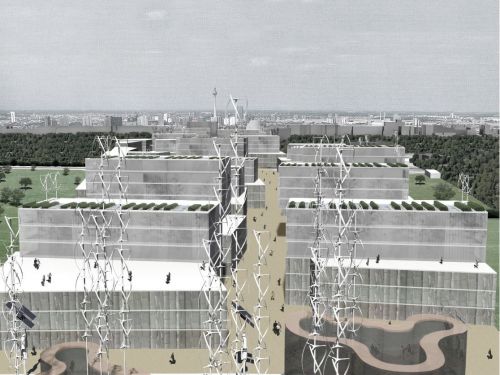
Cliente: senatsverwaltung fur stadtentwicklung, berlino
Concorso "prozessuale stadtentwicklung tempelhofer feld - columbiaquartier" concorso internazionale su due passi, 2009
Progetto premiato
Area del sito: 368 ettari
Area di progetto: 104 ettari
Tempelhof è stato ricollegato a berlino e alla sua rete metropolitana metropolitana. Affinché diventi parte della città, è imperativo che il feld sia collegato alle stazioni u.bahn e s-bahn. Ciò può essere ottenuto sviluppando nuovi elementi urbani ad alta densità che, uscendo da spazi aperti per ciclisti e pedoni, vengono introdotti nell'ambiente in modo da creare un collegamento fisico e fornire una nuova scala e una nuova funzionalità con la loro dimensione naturale e umana . Il cuore verde di berlino si diffonde verso la città portando usi e atteggiamenti che appartengono al mondo naturale. Si fa strada in città attraverso snelli passaggi costruiti. La forma allungata di questi nuovi quartieri urbani è come tensioni che si estendono tra il feld e la città; il loro scopo è perseguire una continuità fisica che consenta agli abitanti di raggiungere facilmente, e di creare un legame forte e ininterrotto tra condizioni artificiali e naturali. Il principio di base è quello di mantenere i benefici che la vasta area verde vuota offre alla città. In effetti, i nuovi sviluppi non interrompono il flusso naturale dell'aria dal feld; al contrario, le aree sviluppate sono esse stesse influenzate dal cambiamento di aria che viene canalizzato attraverso gli edifici, in modo da assicurare la ventilazione anche ai nuovi spazi pubblici urbani.
Client: senatsverwaltung fur stadtentwicklung, berlin
Competition “prozessuale stadtentwicklung tempelhofer feld – columbiaquartier ”international comeptition on two steps , 2009
Awarded project
Site area: 368 ha
Project area: 104 ha
Tempelhof is being re-connected to berlin and to its metropolitan underground network.in order for it to become part of the city, it is imperative for the feld to be linked to the u.bahn and the s-bahn stations. This can be achieved by developing new high density urban elements which, rising out of open spaces for cyclists and pedestrians, are slotted into the environment so as to create a physical link and provide a new scale and a new functionality with their natural and human dimension. The green heart of berlin spreads towards the city carrying uses and attitudes that belong to the natural world. It makes its way into the city through slender built-up passageways. The elongated shape of these new urban neighbourhoods are like tensors stretching between the feld and the city; their aim is to pursue a physical continuity that will enable inhabitants to reach both easily, and to create a strong and unbroken link between artificial and natural conditions. The underlying principle is to maintain the benefits that the vast empty green area provides to the city. In fact, the new developments do not interrupt the natural air flow from the feld; on the contrary, the developed areas are themselves affected by the change of air which is channelled through the buildings, so as to ensure ventilation also to the new urban public spaces.
Invia una richiesta di lavoro a Sergio Pascolo
Trova i migliori Architetti a
Roma| Milano| Napoli| Torino| Palermo| Genova| Bologna| Firenze| Bari| Catania| Venezia| Verona| Messina| Padova| Trieste| Taranto| Brescia| Parma| Prato| Modena| Perugia| Ravenna| Livorno| Cagliari
Vedi tutti
Trova altri professionisti a Venezia
Architetti| Imprese Edili| Imprese di Impianti Elettrici ed Elettricisti| Imprese di Traslochi| Imprese di Ponteggi| Imprese di Costruzioni Ecologiche| Ingegneri Edili| Imprese di Tende da Interni| Imprese di Bonifica Eternit| Rivenditori di Arredo Giardino ed Esterni| Rivenditori di Camini e Stufe| Rivenditori di Cucine| Geometri| Rivenditori di Illuminazione| Rivenditori di Arredamento| Rivenditori di Pavimenti e Rivestimenti| Fotografi di Interni| Rivenditori di Piscine| Designer di Interni| Artisti| Imprese di Tinteggiature| Parquettisti| Marmisti| Imprese di Impianti di Climatizzazione
Vedi tutti
Architetti vicino a te

